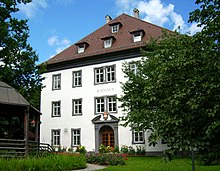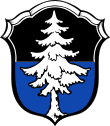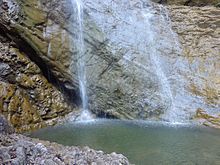Bad Hindelang
| coat of arms | Germany map | |
|---|---|---|

|
Coordinates: 47 ° 30 ' N , 10 ° 22' E |
|
| Basic data | ||
| State : | Bavaria | |
| Administrative region : | Swabia | |
| County : | Oberallgäu | |
| Height : | 825 m above sea level NHN | |
| Area : | 137.18 km 2 | |
| Residents: | 5176 (Dec. 31, 2019) | |
| Population density : | 38 inhabitants per km 2 | |
| Postal code : | 87541 | |
| Area code : | 08324 | |
| License plate : | OA | |
| Community key : | 09 7 80 123 | |
| Market structure: | 12 parts of the community | |
Market administration address : |
Marktstrasse 9 87541 Bad Hindelang |
|
| Website : | ||
| First Mayor : | Sabine Rödel ( CSU ) | |
| Location of the Bad Hindelang market in the Oberallgäu district | ||
Bad Hindelang is a market in the Swabian district of Oberallgäu ( Bavaria ).
geography
location
The place has been a climatic health resort and Kneipp spa since 2001. It is located in the Ostrach Valley on the northern edge of the Limestone Alps on the historic Salt Road , which today leads as federal road 308 via Oberjoch to Austria . The Oberjochpass applies with 107 curves as the most winding road in Germany .
More than 80% of the municipal area is landscape or even nature reserve.
Community structure
The municipality has 12 officially named municipality parts :
- The main town Bad Hindelang (825 m) with the village of Gailenberg (989 m)
- The village of Vorderhindelang (832 m) with the church village Liebenstein , the village Reckenberg and the hamlets of Groß and Riedle
- The village of Bad Oberdorf (822 m). Because of its sulfur moor bath, it was given the title of bath by Prince Regent Luitpold of Bavaria long before the main town of Bad Hindelang (1900).
- The parish village of Hinterstein (866 m) with the village of Bruck
- The parish village of Oberjoch (1136 m)
- The parish village Unterjoch (1013 m)
The municipality extends at an altitude of 780 m (Ostrachbrücke near Reckenberg) up to 2592 m ( Hochvogel ).
history
Until the 19th century
It is certain that in 1540 the Counts of Montfort had the mule track over the yoke expanded as a road. For centuries, salt was transported from Tyrol towards Lake Constance on this route . 1150 an Oggoz is named by Hundilanc. The knight family von Hundilanc is mentioned in various documents in the following years up to 1402. In 1377 Hindelang was assigned to the parish of Sonthofen before it was raised to a separate parish in 1435. As early as 1429, the Augsburg bishop granted the town market rights . In 1529 the Fuggers founded a mare farm in the valley. After the knights of Heimenhofen and the counts of Montfort, the prince-bishops of Augsburg owned the area.
In the rear of the Ostrach valley, iron ore was mined in the 16th century and hammer forges were built in which thousands of halberds and spears were made for the armies of Emperor Maximilian, among others. During the Thirty Years' War almost 1,000 people - half of the population at the time - fell victim to the plague . In 1796 imperial troops on the Jochpass successfully prevented the Napoleonic troops from crossing to Tyrol.
With the secularization in 1803 Hindelang fell to the Kingdom of Bavaria . In 1823 the transport of salt over the yoke came to a standstill. In the years 1895–1898 the new Jochpass road was built. In 1900, Prince Regent Luitpold awarded the Oberdorf district the title "Bad".
20th and 21st centuries
In 1905 the Kraftpost line was opened, which connected Hindelang with Sonthofen train station. In 1924, a flood of the torrent devastated the Bad Oberdorf district. In the 1930s the new Jochpassstraße was renovated (recognizable by the knight's cross carved on a stone wall next to the road in the upper third of the route, towards Oberjoch). During the Second World War it served armed forces units as a route to the front in Italy and Austria.
In 1965, Hindelang was given the title of “climatic and Kneipp spa ”. In 2002 Hindelang became "Bad Hindelang". In 2011 Bad Hindelang received the seal of quality for allergy-friendliness from the European Foundation for Allergy Research (ECARF)
Incorporations
On April 1, 1972, the previously independent community of Unterjoch, which had been formed on January 4, 1867 from parts of the Hindelang community, was reintegrated.
Population development
Between 1988 and 2008 Bad Hindelang grew by 197 inhabitants or around 4%. Between 1988 and 2018, the municipality grew from 4718 to 5168 by 450 inhabitants or 9.5%.
The following figures refer to the territorial status on May 25, 1987.
| Population development | ||||||||||||||
|---|---|---|---|---|---|---|---|---|---|---|---|---|---|---|
| year | 1840 | 1900 | 1939 | 1950 | 1961 | 1970 | 1987 | 1995 | 2000 | 2005 | 2010 | 2015 | ||
| Residents | 2329 | 2641 | 4153 | 5606 | 4956 | 4806 | 4648 | 4979 | 4840 | 4892 | 4815 | 5033 | ||
politics
Municipal council
The election on March 15, 2020 had the following result:
| Party / list | Share of votes | Seats |
| Free electorate Hindelang | 19.50% | 4th |
| Free voter community Bad Oberdorf | 21.61% | 4th |
| Free electoral block Vorderhindelang | 15.66% | 3 |
| Christian Social Union (CSU) | 13.36% | 3 |
| Non-party electorate Hinterstein / Bruck | 12.71% | 2 |
| Bourgeois non-party electorate Unterjoch | 8.15% | 2 |
| Voting community Oberjoch | 9.00% | 2 |
The 1st mayor is an additional member of the municipal council.
The municipal council for the 2014 to 2020 term of office was composed as follows:
| Party / list | Share of votes | Seats |
| Free electorate Hindelang | 19.7% | 3 |
| Free voter community Bad Oberdorf | 17.0% | 3 |
| Free electoral block Vorderhindelang | 15.2% | 3 |
| Christian Social Union (CSU) | 15.1% | 2 |
| Non-party electorate Hinterstein / Bruck | 11.5% | 2 |
| Bourgeois non-party electorate Unterjoch | 7.7% | 1 |
| Social Democratic Party of Germany (SPD) / Greens | 7.0% | 1 |
| Voting community Oberjoch | 6.8% | 1 |
mayor
|
|
coat of arms
The coat of arms was awarded to the community on August 31, 1872 by Ludwig II . The official blazon reads: "Divided by black and blue, applied a rooted silver fir tree."
Culture and sights
- Church of Our Lady in Ostrachtal and St. Jodokus
- Protestant church
- Local history museum in the Upper Mill in the Bad Oberdorf district
- Peace history museum in the Bad Oberdorf district
- Hinterstein Carriage Museum
- Town hall - former hunting lodge: built in 1660 by the Prince-Bishop of Augsburg, Sigismund Franz, Archduke of Tyrol, as a hunting lodge. Summer residence of the prince-bishops of Augsburg until 1805. After the secularization , the castle passed into state ownership, then served privately as an inn ("zum Hasen") and schoolhouse for a few years, until it was expanded into the town hall of the market. The former house chapel of the prince-bishops is well worth seeing with its early baroque vault decoration and a green-glazed rococo tiled stove.
- The former Fugger mare farm later became the property of the salt factor.
- Dreikugelhaus , former official and residence of the salt factor.
- Hammersmiths in the Ostrachtal - After the Counts of Montfort were awarded the mining regalia at the beginning of the 16th century, they opened several ore mines in the Hintersteiner Tal in what is now the municipality of Bad Hindelang. The ore obtained was smelted in the smelter between Hinterstein and Oberdorf. A considerable "armaments industry" emerged: from records in Innsbruck it appears that z. For example, in the years 1520–1524 almost 20,000 Landsknecht skewers were delivered from the Hindelang armory for the armies of Emperor Maximilian . Three of these old hammer mills still exist today. Today more peaceful devices are produced here, u. a. wrought iron frying pans.
- The International Jochpass Race Memorial , which has been held annually since 1999, is a popular historic hill climb for vintage and youngtimer vehicles.
- The Hindelang adventure Christmas market attracts around 60,000 visitors every year.
Illustrations
The so-called salt fountain is reminiscent of the salt trade over the Oberjoch Pass
Mountain hiking trails
- Jubilee path from the Willersalpe to the Prinz-Luitpold-Haus
- Hindelanger via ferrata
- Mountain Rescue Trail
- Fatherland Way
Personalities
art
- The artist brothers Franz Xaver Eberhard (1767–1836) and Konrad Eberhard (1768–1859) from Hindelang left behind numerous sculptural works in Hindelang and in the wider area.
- Richard Mahn (* 1866 Leipzig, † 1951 Hindelang), painter, graphic artist, etcher and illustrator. In 1901 he bought a house in Bad Oberdorf. After the First World War, he moved from Munich to Bad Oberdorf and lived there until his death in 1951.
- Fritz von Kamptz (born February 16, 1866 Glogau, † February 15, 1938 Hindelang), painter, lived in Hindelang from 1932 until his death. His image of Christ made him famous.
- Carl Horn (1874–1945), painter, died in Hindelang
- Charley Peklo (born August 23, 1880 Taus, † November 6, 1959 Immenstadt), painter, lived in Hindelang after the Second World War.
- Walter Jacob (born October 21, 1893 Altenburg / Thuringia, † July 13, 1964 Hindelang), lived as a painter after the Second World War until his death in Hindelang; he belonged to the second generation of Expressionism in Germany.
- Sepp Rist (1900–1980), b. in Hindelang, film actor who has appeared in numerous mountain and homeland films.
- Maria Antonie (Toni) Gaßner-Wechs (1900–1956) and her husband Josef Gaßner (1898–1954) wrote numerous poems and texts as well as several stage plays, mostly in the Alemannic dialect of the Ostrach Valley.
- Maria Blanz (1912–1995), painter in Hindelang. Studied at a private art school in Munich in 1939, then studied at the art academy from 1943 to 1946. After returning home, she painted landscapes in oils and watercolors. Likewise portraits, flowers, animals and still lifes. (from Ulrich Scholl, From the history of the Ostrachtal, 1986, Hindelang)
- Christian Modersohn (born October 13, 1916, † December 24, 2009), son of Otto Modersohn , painter, grew up in Hindelang and lived in Gailenberg until 1957.
- Kilian Lipp (* 1953 in the district of Vorderhindelang ), painter, works as a freelance artist in Gailenberg .
- Willi Tannheimer (* 1940 in the Hinterstein district ), sculptor, works as a freelance artist in Hinterstein / Bruck.
- Hubert Blanz (born February 21, 1969), freelance artist, lives in Vienna
- Christoph Finkel (* 1971), freelance wood sculptor and coach of the national bouldering team
- Aurélie Blanz (* 1973), freelance artist, lives in France
music
- Karl Hafner (1894–1971) set more than 300 dialect poems by the Gaßner couple and by Eugenie Scholl-Rohrmoser to music . They have become folk songs and are sung in many parts of the Allgäu today. In 1960 the community made him an honorary citizen.
- Michael Bredl (1915–1999) was a teacher at the Hindelang elementary school from 1957. Folk music received important impulses from him; the alphorn blowing was revived by him in the Allgäu.
Other
- Elector Clemens Wenzeslaus (1739–1812), Prince-Bishop of Augsburg, liked to spend his summer in the castle in Hindelang.
- Pamela Behr (* 1956), former alpine ski runner
- Philipp Neri Chrismann (* 1751 in Hindelang, † 1810 Hedingen near Sigmaringen), fundamental theologian of the Franciscan order.
- Prince Regent Luitpold of Bavaria (1821–1912) came to the Ostrach Valley to hunt for more than fifty years.
- The Counts Fugger acquired larger property in the Ostrachtal in 1529 and established horse breeding here (Stutenhof).
- Thomas Wechs (1893–1970) built numerous modern church buildings in the diocese of Augsburg, including the Church of Our Lady in the Ostrachtal and St. Jodokus in his birthplace Bad Oberdorf . An architecture award is named after him.
- Hans-Peter Lanig , b. 1935, and his sister Evi were famous skiers in the 1950s. Hans-Peter won the silver medal at the 1960 Winter Olympics in Squaw Valley.
- Anton Morent (1924–2006), bus entrepreneur, mentor for tourism in Oberallgäu and holder of the Federal Cross of Merit.
- Gerhard Gehring (* 1945), biathlete and cross-country skier, born in the Unterjoch district
- Horst Zuse (* 1945), professor and son of the computer pioneer Konrad Zuse , was born here.
- Harry Voigtsberger (* 1950), politician (SPD)
- Dieter Fersch (* 1946), ski racer
- Klaus Hulek (* 1952), mathematician
Web links
- Homepage Market Bad Hindelang
- Peace History Museum
- Local museum
- Entry on the coat of arms of Bad Hindelang in the database of the House of Bavarian History
Individual evidence
- ↑ "Data 2" sheet, Statistical Report A1200C 202041 Population of the municipalities, districts and administrative districts 1st quarter 2020 (population based on the 2011 census) ( help ).
- ^ Community: The market community council - your political representatives from Bad Hindelang. Retrieved May 24, 2020 .
- ^ Community Bad Hindelang in the local database of the Bavarian State Library Online . Bavarian State Library, accessed on August 15, 2019.
- ↑ Bad Hindelang receives the seal of quality for allergy-friendliness ( Memento from May 21, 2011 in the Internet Archive )
- ^ Wilhelm Volkert (ed.): Handbook of Bavarian offices, communities and courts 1799–1980 . CH Beck, Munich 1983, ISBN 3-406-09669-7 , p. 571 .
- ^ Bavarian State Office for Statistics
- ↑ Hindelang Mayor Adalbert Martin is dead
- ↑ Dr. Sabine Rödel wins mayoral election in Bad Hindelang
- ^ Official description of the coat of arms on the website of the House of Bavarian History, accessed on September 25, 2015.
- ↑ Hubert Blanz at kultur-oa.de
- ↑ Brief portrait of Aurélie Blanz at www.kultur-oa.de by Gunther le Maire
























